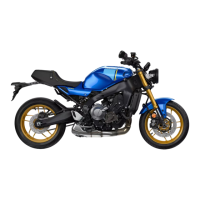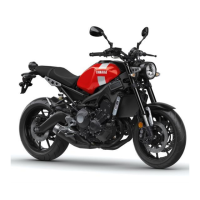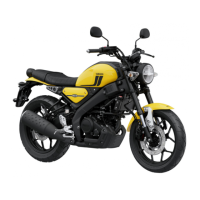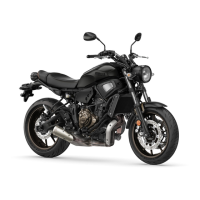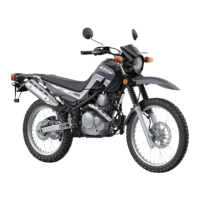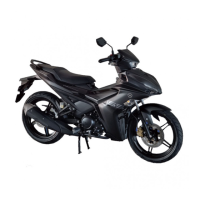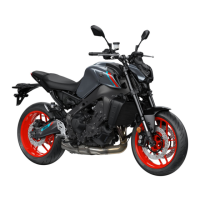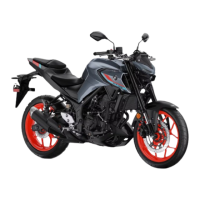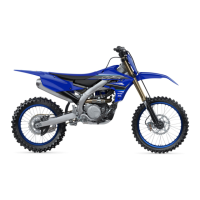Do you have a question about the Yamaha XSR900 2021 and is the answer not in the manual?
Emphasizes owner's role in safe operation, rider skills, and training.
Covers pre-operation checks, visibility, and accident avoidance strategies.
Details the necessity of helmets, eye protection, and protective clothing for rider safety.
Warns about the dangers of carbon monoxide from exhaust in enclosed areas.
Guidelines for adding cargo to maintain stability and avoid accidents.
Discusses potential safety hazards of non-genuine parts and modifications.
Instructions for safely transporting the motorcycle in another vehicle.
Illustrates and labels parts visible from the left side of the motorcycle.
Illustrates and labels parts visible from the right side of the motorcycle.
Identifies and describes handlebar controls and instrument panel components.
Explains the function and positions of the main switch and steering lock.
Details the meaning and function of various indicator and warning lights on the panel.
Describes the various displays and functions of the meter unit, including speedometer, tachometer, etc.
Explains how to monitor engine speed and avoid the tachometer's red zone.
Describes how the fuel meter indicates the amount of fuel in the tank.
Indicates when the vehicle is operated in an environmentally friendly, fuel-efficient manner.
Shows the currently selected gear and neutral position indicator.
Explains the different D-mode selections (STD, A, B) for engine performance.
Details the function of left and right handlebar switches for various operations.
Explains how to use the clutch lever for disengaging/engaging the drivetrain.
Describes how to operate the shift pedal for changing gears.
Explains how to apply the front brake using the lever.
Describes the Anti-lock Brake System and its operation.
Explains how the TCS maintains traction during acceleration and on slippery surfaces.
Instructions on how to open and close the fuel tank cap safely.
Provides guidelines and warnings for refueling the vehicle safely.
Explains the function of the catalytic converter and exhaust system heat.
Details the location and capacity of the under-seat storage compartment.
Instructions for adjusting front fork spring preload and rebound damping.
Information on the auxiliary DC connector for accessories.
Describes the sidestand's operation and its role in the ignition cut-off system.
Explains the system that prevents starting under unsafe conditions.
Steps to check fuel level, line, and tank breather hose before riding.
Procedures for checking engine oil level and for oil leakage.
Steps to check coolant level and for cooling system leakage.
Checks for front brake operation, pads, and fluid level.
Checks for rear brake operation, pads, and fluid level.
Checks clutch operation, cable, and lever free play.
Ensures smooth throttle operation and checks grip free play.
Checks drive chain slack, alignment, and condition.
Inspects wheels and tires for damage, tread depth, and air pressure.
Ensures smooth sidestand operation and lubrication.
Checks operation of vehicle instruments, lights, and switches.
Provides guidelines for the initial engine break-in period to ensure longevity.
Step-by-step instructions for starting the motorcycle's engine.
Explains how to shift gears for acceleration, deceleration, and neutral.
Covers steps for safely parking the motorcycle and shutting it off.
Locates the provided tool kit and its intended use for basic repairs.
Outlines required maintenance for emission control systems at specific intervals.
Details routine checks, adjustments, and lubrication for various vehicle components.
Guides on inspecting spark plug condition, gap, and their relation to engine health.
Instructions for checking, changing, and replacing engine oil and filter.
Provides guidance on checking and changing the engine coolant level.
Explains the replacement intervals for the air filter element.
How to check and adjust the engine's idling speed for proper operation.
Importance of tire condition, pressure, and replacement for safety.
Advice on checking cast wheels for damage and ensuring proper balancing.
Steps to measure and adjust the free play in the clutch lever.
Ensures there is no free play at the brake lever end for optimal braking.
Explains the function of brake light switches and their servicing.
How to check brake pads for wear using indicators or grooves.
Procedures for checking brake fluid level and replenishing if necessary.
Recommends changing brake fluid and replacing seals/hoses at intervals.
How to check and adjust drive chain slack for proper operation and longevity.
Steps for cleaning and lubricating the drive chain to prevent wear.
Ensures smooth operation of control cables through checking and lubrication.
Ensures smooth pedal operation by checking and lubricating pivots.
Ensures smooth lever operation by checking and lubricating pivots.
Ensures smooth sidestand operation and lubrication of pivot points.
Guides on lubricating swingarm pivots at specified intervals for smooth suspension.
How to check the condition and operation of the front fork.
How to check for worn or loose steering bearings that could cause danger.
How to check front and rear wheel bearings for play or smooth operation.
Information on the VRLA battery type, lead connections, and charging.
How to access and replace fuses in the fuse boxes.
Step-by-step guide for replacing the headlight bulb.
Guide for replacing a burnt-out turn signal light bulb.
General advice on diagnosing and resolving common motorcycle issues.
Quick procedures for checking fuel, battery, ignition, and compression systems.
Steps to take if the engine overheats, including checking coolant.
Advises on proper cleaning products for matte finished parts to avoid damage.
Guidelines for washing, cleaning, and polishing the vehicle for appearance and performance.
Recommends proper storage conditions to protect the vehicle from dust and corrosion.
Detailed steps for preparing the motorcycle for storage exceeding 60 days.
Explains where to find and record key vehicle identification numbers.
Information on the model label affixed to the frame for spare parts ordering.
Details the label showing specifications related to exhaust emissions.
Locates the diagnostic connector used for vehicle data and troubleshooting.
Explains the vehicle data stored by the ECU and its handling.
How to report safety defects to NHTSA and Yamaha Motor Corporation.
Prohibits tampering with noise control systems and lists affected components.
A template for recording vehicle maintenance services for warranty purposes.
Outlines the terms, conditions, and exclusions of the vehicle's limited warranty.
Addresses common customer questions regarding warranty coverage and responsibilities.
Information about Yamaha's extended service plans for additional protection.
Emphasizes owner's role in safe operation, rider skills, and training.
Covers pre-operation checks, visibility, and accident avoidance strategies.
Details the necessity of helmets, eye protection, and protective clothing for rider safety.
Warns about the dangers of carbon monoxide from exhaust in enclosed areas.
Guidelines for adding cargo to maintain stability and avoid accidents.
Discusses potential safety hazards of non-genuine parts and modifications.
Instructions for safely transporting the motorcycle in another vehicle.
Illustrates and labels parts visible from the left side of the motorcycle.
Illustrates and labels parts visible from the right side of the motorcycle.
Identifies and describes handlebar controls and instrument panel components.
Explains the function and positions of the main switch and steering lock.
Details the meaning and function of various indicator and warning lights on the panel.
Describes the various displays and functions of the meter unit, including speedometer, tachometer, etc.
Explains how to monitor engine speed and avoid the tachometer's red zone.
Describes how the fuel meter indicates the amount of fuel in the tank.
Indicates when the vehicle is operated in an environmentally friendly, fuel-efficient manner.
Shows the currently selected gear and neutral position indicator.
Explains the different D-mode selections (STD, A, B) for engine performance.
Details the function of left and right handlebar switches for various operations.
Explains how to use the clutch lever for disengaging/engaging the drivetrain.
Describes how to operate the shift pedal for changing gears.
Explains how to apply the front brake using the lever.
Describes the Anti-lock Brake System and its operation.
Explains how the TCS maintains traction during acceleration and on slippery surfaces.
Instructions on how to open and close the fuel tank cap safely.
Provides guidelines and warnings for refueling the vehicle safely.
Explains the function of the catalytic converter and exhaust system heat.
Details the location and capacity of the under-seat storage compartment.
Instructions for adjusting front fork spring preload and rebound damping.
Information on the auxiliary DC connector for accessories.
Describes the sidestand's operation and its role in the ignition cut-off system.
Explains the system that prevents starting under unsafe conditions.
Steps to check fuel level, line, and tank breather hose before riding.
Procedures for checking engine oil level and for oil leakage.
Steps to check coolant level and for cooling system leakage.
Checks for front brake operation, pads, and fluid level.
Checks for rear brake operation, pads, and fluid level.
Checks clutch operation, cable, and lever free play.
Ensures smooth throttle operation and checks grip free play.
Checks drive chain slack, alignment, and condition.
Inspects wheels and tires for damage, tread depth, and air pressure.
Ensures smooth sidestand operation and lubrication.
Checks operation of vehicle instruments, lights, and switches.
Provides guidelines for the initial engine break-in period to ensure longevity.
Step-by-step instructions for starting the motorcycle's engine.
Explains how to shift gears for acceleration, deceleration, and neutral.
Covers steps for safely parking the motorcycle and shutting it off.
Locates the provided tool kit and its intended use for basic repairs.
Outlines required maintenance for emission control systems at specific intervals.
Details routine checks, adjustments, and lubrication for various vehicle components.
Guides on inspecting spark plug condition, gap, and their relation to engine health.
Instructions for checking, changing, and replacing engine oil and filter.
Provides guidance on checking and changing the engine coolant level.
Explains the replacement intervals for the air filter element.
How to check and adjust the engine's idling speed for proper operation.
Importance of tire condition, pressure, and replacement for safety.
Advice on checking cast wheels for damage and ensuring proper balancing.
Steps to measure and adjust the free play in the clutch lever.
Ensures there is no free play at the brake lever end for optimal braking.
Explains the function of brake light switches and their servicing.
How to check brake pads for wear using indicators or grooves.
Procedures for checking brake fluid level and replenishing if necessary.
Recommends changing brake fluid and replacing seals/hoses at intervals.
How to check and adjust drive chain slack for proper operation and longevity.
Steps for cleaning and lubricating the drive chain to prevent wear.
Ensures smooth operation of control cables through checking and lubrication.
Ensures smooth pedal operation by checking and lubricating pivots.
Ensures smooth lever operation by checking and lubricating pivots.
Ensures smooth sidestand operation and lubrication of pivot points.
Guides on lubricating swingarm pivots at specified intervals for smooth suspension.
How to check the condition and operation of the front fork.
How to check for worn or loose steering bearings that could cause danger.
How to check front and rear wheel bearings for play or smooth operation.
Information on the VRLA battery type, lead connections, and charging.
How to access and replace fuses in the fuse boxes.
Step-by-step guide for replacing the headlight bulb.
Guide for replacing a burnt-out turn signal light bulb.
General advice on diagnosing and resolving common motorcycle issues.
Quick procedures for checking fuel, battery, ignition, and compression systems.
Steps to take if the engine overheats, including checking coolant.
Advises on proper cleaning products for matte finished parts to avoid damage.
Guidelines for washing, cleaning, and polishing the vehicle for appearance and performance.
Recommends proper storage conditions to protect the vehicle from dust and corrosion.
Detailed steps for preparing the motorcycle for storage exceeding 60 days.
Explains where to find and record key vehicle identification numbers.
Information on the model label affixed to the frame for spare parts ordering.
Details the label showing specifications related to exhaust emissions.
Locates the diagnostic connector used for vehicle data and troubleshooting.
Explains the vehicle data stored by the ECU and its handling.
How to report safety defects to NHTSA and Yamaha Motor Corporation.
Prohibits tampering with noise control systems and lists affected components.
A template for recording vehicle maintenance services for warranty purposes.
Outlines the terms, conditions, and exclusions of the vehicle's limited warranty.
Addresses common customer questions regarding warranty coverage and responsibilities.
Information about Yamaha's extended service plans for additional protection.
| Displacement | 889cc |
|---|---|
| Bore x Stroke | 78.0mm x 62.1mm |
| Compression Ratio | 11.5:1 |
| Fuel System | Fuel injection |
| Ignition System | TCI: Transistor Controlled Ignition |
| Final Drive | Chain |
| Front Brakes | Dual 298mm hydraulic disc; ABS |
| Rear Brakes | 245mm hydraulic disc; ABS |
| Front Tire | 120/70ZR17 |
| Rear Tire | 180/55ZR17 |
| Engine Type | Liquid-cooled, DOHC, inline 3-cylinder |
| Transmission | 6-speed |
| Front Suspension | Telescopic fork |
| Rear Suspension | Single shock, adjustable preload and rebound damping |
| Dimensions (L x W x H) | 2, 160 mm x 860 mm x 1, 150 mm |
| Fuel Capacity | 14 L |
| Horsepower | 117 hp |
| Torque | 93 Nm |
